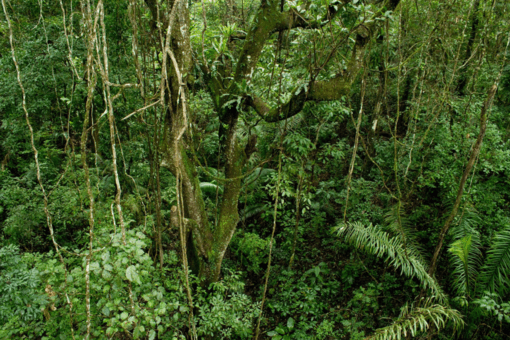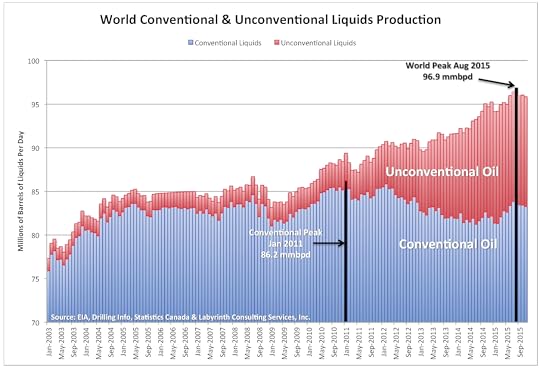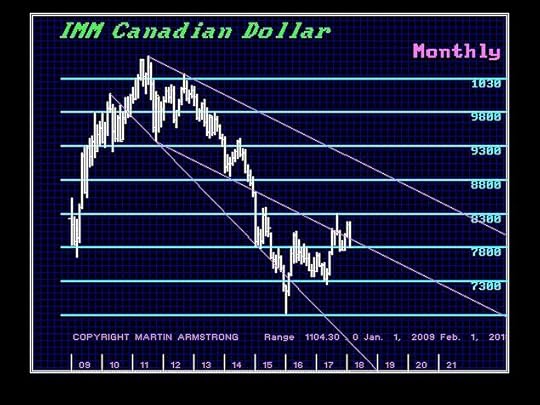Steve Bull's Blog, page 1171
March 7, 2018
Normalizing Extinction

Photo by Brian Gratwicke | CC BY 2.0
Several years back I had the good fortune of traveling through the rainforest in a remote part of Panama. Along the way I stayed in a small cabin at an ecolodge with the warm waters of the Caribbean Sea just steps away. There were no roads, televisions, or internet access, and no phones or electricity except in the main house. Out back was a trail that meandered through a dense forest brimming with tree frogs, sloths, iguanas, leaf cutter ants, and countless species of birds hopping from branch to branch. Just a couple feet into the water and I counted dozens of bright orange sea stars. And at night the sea shore came alive with biolumeniscent dinoflagellates, who would respond to my flashlight signals in short bursts of blue-green neon and the canopy was a cacophony of countless species in song. The abundance of life in that tiny corner of the world crowded out most signals of modern civilization.
But as with any trip like this, I eventually had to return home where the reality of “The Great Dying” is everywhere. Like climate change, the Sixth Mass Extinction, is not a hyperbolic, political trope. It is in fact the death of most complex forms of life on earth at our own hands. And by all accounts, with mass die offs of bees, coral, salmon, frogs and beyond, it is in full swing. Elizabeth Kolbert, author of The Sixth Extinction makes this plain:
“If we assume, very conservatively, that there are two million species in the tropical rainforests, this means that something like five thousand species are being lost each year. This comes to roughly fourteen species a day, or one every hundred minutes.”
…click on the above link to read the rest of the article…
The Current Onset of Climate Tipping Points
As extreme temperatures, the rate of sea ice melt, the collapse of Greenland glaciers, the thawing of Siberian and Canadian permafrost and increased evaporation in the Arctic drive cold snow storms into Europe and North America, and as hurricanes and wild fires affect tropical and semi-tropical parts of the globe, it is becoming clear Earth is entering a shift in state of the atmosphere-ocean system associated with destructive climate tipping points. As Arctic permafrost is thawing an analogy with geological methane-release events such as the 56 million years-old Paleocene-Eocene boundary thermal maximum (PETM) event is becoming more likely.
As is well known to students of the history of the climate, once a temperature threshold is breached, abrupt weather events ensue amplified by feedbacks such as decreased reflectivity of the Earth surface and enhanced release of greenhouse gases, often within short time frames.

Figure 1. 1880-2018 annual mean temperatures and 5-years smoothing.
Such abrupt changes are occurring at present. As mean global temperature has exceeded 1.2 degrees Celsius above 1880 temperatures (Figure 1), sharp reductions occur in Arctic sea ice from 45 percent in 1985 to 21 percent in 2017, when the ice cover was 8.5 percent lower than the average of 1981-2010.
As the ice melts the near-total reflection (high albedo) of solar radiation from the ice is replaced by absorption of infrared radiation by open water; The flow of ice-melt water from the Greenland glaciers creates a large pool of cold water in the North Atlantic Ocean. The cold water region south of Greenland slows-down to aborts northward flow of the thermohaline Atlantic Meridional Ocean Circulation (AMOC), leading to cooling of the North Atlantic and adjacent North America and Europe.
…click on the above link to read the rest of the article…
March 6, 2018
Italian Elections – Another Nail in the Coffin of Brussels?
 The Italian election results are in and once again it demonstrates that correlating economics with voting, you end up with a far more accurate forecast. Trying to predict based upon samples of calling people appears to be not merely questionable, but also prone to human bias. We have been warning that this trend toward nationalism is growing worldwide and especially within Europe. The Italian vote proves that the refugee issue is a major crisis and the people do not support it. Civil Unrest in Ital has been rising, but nobody listens to the people.
The Italian election results are in and once again it demonstrates that correlating economics with voting, you end up with a far more accurate forecast. Trying to predict based upon samples of calling people appears to be not merely questionable, but also prone to human bias. We have been warning that this trend toward nationalism is growing worldwide and especially within Europe. The Italian vote proves that the refugee issue is a major crisis and the people do not support it. Civil Unrest in Ital has been rising, but nobody listens to the people.
The politicians in Europe and even in the United States with respect to Trump, have assumed that this is merely a populist movement that would quickly fade into memory. Career politicians have had it their way for so long, they cannot fathom why after robbing the Treasury for decades and nobody said anything, why are the people suddenly mad now? The Italian vote should be a wake-up call to Brussels, but they will remain in a state of denial. Their attempt to PUNISH Britain they believed would prevent other states from leaving. They are sadly mistaken.
A majority of Italian voters have spoken and they supported the Eurosceptic candidates in the national election. Italy had been a steadfast championed the European project. However, the dreams have fallen to the ground as dusk in the winds of politics. Those in Brussels have been totally dishonest with the European people swearing that a single currency would solve all the ills and that they were not trying to take over Europe making it the United States of Europe with one government. The promise that a single currency would also produce a single interest rate for all proved also a complete lie.
…click on the above link to read the rest of the article…
Foreign Investment into Canada Has Collapsed by 26% in 2017
Foreign direct investment into Canada has absolutely plunged during 2017 to the lowest since 2010. There has been an effort to stop the sale of any property to foreign investors mainly from China. On top of that, there has been also a collapse in capital investment into the oil industry. There are fears also rising about an exodus of capital from the nation’s oil patch and worries about the fate of the North American Free Trade Agreement (NAFTA).
Direct investment into Canada declined by a stunning 26% dropping to merely $33.8 billion during 2017, according to Statistics Canada. Capital inflows have declined for the second year with the major high in 2015 in accordance with our Economic Confidence Model. The investment that did take place was from reinvested earnings of existing operations. Net foreign purchases of Canadian businesses turned negative for the first time in a decade. This means that foreign companies sold more Canadian businesses than they bought. The political shift in Canada to the left is also being seen as a political risk for the years ahead. A monthly closing BELOW 7305 on the futures will signal the collapse of the C$ is underway once again.
Europe Will Retaliate To Trump Trade War With 25% Tariffs Targeting GOP States
Following through with threats of retaliation made earlier in the week, the European Union on Tuesday is preparing punitive tariffs on iconic US brands produced in Republican-controlled states as US trade partners try to do anything and everything they can to stymie President Trump push to impose massive tariffs on steel and aluminum imports.

In what would be the second shot fired in a global trade war launched by Trump, the EU’s tariffs would target (a relatively modest) €2.8 billion ($3.5 billion) of American goods, with Brussels aiming to apply a 25% tit-for-tat levy on a range of consumer, agricultural and steel products imported from the US. The list of targeted US goods, which includes motorcycles, jeans and bourbon whiskey, is intended to send a political message to Washington about the potential domestic economic costs of making good on the president’s threat.
The EU’s retaliatory list targets imports from the U.S. of shirts, jeans, cosmetics, other consumer goods, motorbikes and pleasure boats worth around 1 billion euros; orange juice, bourbon whiskey, corn and other agricultural products totaling 951 million euros; and steel and other industrial products valued at 854 million euros. The Brussels-based commission, the EU’s executive arm, discussed the retaliatory measures with representatives of the bloc’s governments at a meeting on Monday evening.
Paul Ryan, Republican speaker of the House of Representatives, comes from Wisconsin, the state where motorbike maker Harley-Davidson Inc. is based. Earlier this week, Ryan said he was “extremely worried about the consequences of a trade war” and has urged Trump to drop his tariff proposal.

Ryan wouldn’t be the only US official to feel the pressure. According to Bloomberg’s strategic hot take, Bourbon whiskey is produced in Senate Majority Leader Mitch McConnell’s home state of Kentucky, while San Francisco-based jeans maker Levi Strauss is headquartered in House Minority Leader Nancy Pelosi’s district.
…click on the above link to read the rest of the article…
3 Economic Fallacies That Just Won’t Die

3 Economic Fallacies That Just Won’t Die
Henry Hazlitt discussed, dissected, and debunked 22 economic sophisms in his classic work ‘Economics in One Lesson.’
In any academic discipline, one can find two types of experts: those who are incapable of explaining complex ideas in a simple manner; and those capable of making the difficult look easy. This year marks the 25th anniversary of the death Henry Hazlitt, one of the few economists who belongs to the second group.
Born in Philadelphia in 1894, Hazlitt developed his career as a journalist in the most influential newspapers and magazines of the country, starting at The Wall Street Journal as a typographer in 1914. During the 1920s, he wrote for several printed media outlets, including The New York Evening Post and The Nation, of which he was appointed literary director.
Hazlitt pointed out that short-sighted economic policies aimed at satisfying the claims of particular groups end up reducing the welfare of the majority.
In 1934, Hazlitt became the chief editorial writer of The New York Times, where he gained a reputation for writing about economics and finance from a free-market perspective. His outspoken opposition to the Bretton Woods Agreement had him fired after 12 successful years at the most important newspaper of the Big Apple. Yet he continued to be dedicated to his passion for writing until his death in 1993.
Despite his lack of formal academic training, Hazlitt showed a deep interest in the field of economics, which led him to write several books on the topic. In 1946, he published one of the best introductory texts on economics ever written: Economics in One Lesson.
Following the steps of the 19th-century French economist Frédéric Bastiat, Hazlitt pointed out that short-sighted economic policies aimed at satisfying the claims of particular groups inevitably end up reducing the welfare of the majority of the population. In his own words,
…click on the above link to read the rest of the article…
Is MSNBC Now the Most Dangerous Warmonger Network?
A recent study revealed that MSNBC’s coverage of ‘Russiagate’ vastly outweighs its coverage of other issues, such as the US-backed humanitarian crisis in Yemen, and the network’s refusal to correct the disparity could lead to dangerous conclusions, notes Norman Solomon.
The evidence is damning. And the silence underscores the arrogance.

The MSNBC logo (Wikipedia)
More than seven weeks after a devastating report from the media watch group FAIR, top executives and prime-time anchors at MSNBC still refuse to discuss how the network’s obsession with Russia has thrown minimal journalistic standards out the window.
FAIR’s study, “MSNBC Ignores Catastrophic U.S.-Backed War in Yemen,” documented a picture of extreme journalistic malfeasance at MSNBC:
— “An analysis by FAIR has found that the leading liberal cable network did not run a single segment devoted specifically to Yemen in the second half of 2017. And in these latter roughly six months of the year, MSNBC ran nearly 5,000 percent more segments that mentioned Russia than segments that mentioned Yemen.”
— “Moreover, in all of 2017, MSNBC only aired one broadcast on the U.S.-backed Saudi airstrikes that have killed thousands of Yemeni civilians. And it never mentioned the impoverished nation’s colossal cholera epidemic, which infected more than 1 million Yemenis in the largest outbreak in recorded history.”
— “All of this is despite the fact that the U.S. government has played a leading role in the 33-month war that has devastated Yemen, selling many billions of dollars of weapons to Saudi Arabia, refueling Saudi warplanes as they relentlessly bomb civilian areas and providing intelligence and military assistance to the Saudi air force.”
Meanwhile, MSNBC’s incessant “Russiagate” coverage has put the network at the media forefront of overheated hyperbole about the Kremlin. And continually piling up the dry tinder of hostility toward Russia boosts the odds of a cataclysmic blowup between the world’s two nuclear superpowers.
…click on the above link to read the rest of the article…
New U.S. Record-Level Oil Production! Peak Oil Theory Disproven! Not.

Well, I’m amazed and impressed. Tight oil production has pushed total United States petroleum output to more than 10 million barrels a day, a rate last seen almost a half-century ago. It’s a new U.S. record. Fifteen years ago I was traveling the world with a Powerpoint presentation featuring a graph of U.S. oil production history. That graph showed a clear peak in 1970 and a long bumpy decline thereafter.

My message: as went the U.S., so would go the world at some point in the fairly near future. Peak oil—the inevitable moment when global oil supplies started drying up—would be a watershed for industrial societies, leading to economic contraction, geopolitical crisis, and social upheaval.
So is it time for a retraction? The optics are certainly unfavorable for peak oil theorists like me. Our forecasts obviously failed, in that none of us expected the current surge in U.S. output. But permit me to offer some context.
Everyone agrees that the surge is almost entirely due to tight oil (globally, there has also been growth in bitumen from Canada, deepwater oil, and other unconventional sources). The application of hydrofracturing and horizontal drilling to low-permeability source rocks in the United States represents an amazing success story for the oil industry—at least in terms of raw petroleum output. But what conditions led to this bonanza?
Return with me now to those thrilling days of yesteryear—the year 2005, to be precise. That’s when the rate of world conventional oil production stopped growing and hit a plateau that continues to this day. Oil prices were already scrambling upward; by mid-2008 they had zoomed to nearly $150 per barrel. And it was at that moment that the global financial crisis erupted. Which was, by most accounts, a survival threat to industrial society.

…click on the above link to read the rest of the article…
Logging Can’t Restore Burnt Forests

Photo by USDA Forest Service Alaska | CC BY 2.0
Every time I drive up to Mount Bachelor in Central Oregon I pass the Deschutes National Forest’s logging and mastication projects. The Forest Service and the Deschutes Collaborative suggest they are “thinning” the forest to preclude large wildfires and to “restore it.” (The collaborative is a working group of various stakeholders who advise the Forest Service about management issues.)
Neither of these assertions is accurate. What they are creating is tree plantations of largely even-aged trees — all done in the name of “fixing” the forest.
The first myth they are selling to the public is that logging can preclude large wildfires. There is a host of research — much by Forest Service’s own fire researchers as well as other ecologists — that concludes that under “extreme fire weather” nothing stops a wildfire.
When you have high temps, low humidity, drought and high winds, wildfires are unstoppable. It does not matter how much “thinning” or other fuel treatment you have done; wildfires will charge through, over and around any “fire break.”
When it appears that a fire break has stopped a blaze, check again. Almost always, the weather has changed. It is weather change, not firefighting, that allows humans to stop large wildfires.
I just visited the Thomas Fire in Southern California, the largest blaze in recent California history. Despite thousands of firefighters, and numerous fire breaks along the pathway of the fire, including 12-lane freeways, the only fire break that halted the Thomas Fire was the Pacific Ocean!
The only way to protect Bend and other communities is through mandatory firewise regulations that include nonflammable roofs, removal of flammable materials from near homes, and planning for rapid evacuation in the event of a wind-driven blaze.
…click on the above link to read the rest of the article…
The Arctic Heats Up in the Dead of Winter

Photo by NOAA Photo Library | CC BY 2.0
Every once in a while a climatic event hits that forces people to sit down to catch their breath. Along those lines, abnormal Arctic heat waves in the dead of winter may force scientists to revaluate downwards (or maybe upwards, depending) their most pessimistic of forecasts.
By the end of February 2018, large portions of the Arctic Ocean north of Greenland were open blue water, meaning no ice. But, it’s wintertime, no daylight 24/7, yet no ice in areas where it’s usually some meters thick! In a remarkable, mindboggling turn of events, thick ice in early February by month’s end turned into wide open blue water, metaphorically equivalent to an airline passenger at 35,000 feet watching rivets pop off the fuselage.
The sea ice north of Greenland is historically the thickest, most solid ice of the North Pole. But, it’s gone all of a sudden! Egads, what’s happening and is it a danger signal? Answer: Probably, depending upon which scientist is consulted. Assuredly, nobody predicted loss of ice north of Greenland in the midst of winter.
Wide open blue seas in the Arctic expose all of humanity to risks of Runaway Global Warming (“RGW”) as, over time, massive amounts of methane erupts with ancillary sizzling of agricultural crops, and as the Arctic heats up much faster than the rest of the planet, this also throws a curve ball at weather patterns all across the Northern Hemisphere, radical weather patterns ensue, like snow on the French Riviera only recently.
According to Ruth Mottram, a climate scientist at the Danish Meteorological Institute in Copenhagen, February was the warmest (hottest) on record in the Arctic, which includes 10 days of temps above freezing.
…click on the above link to read the rest of the article…







